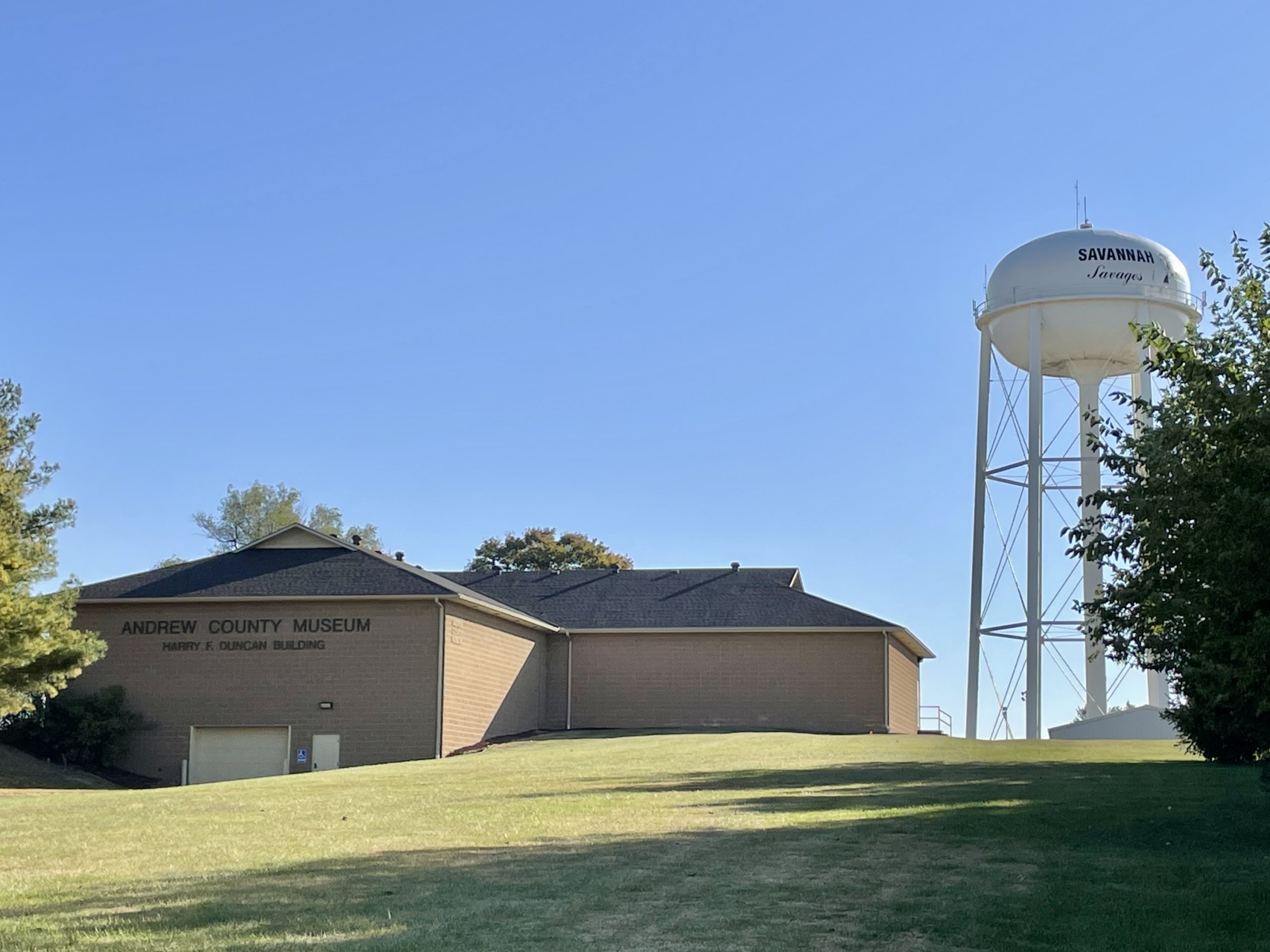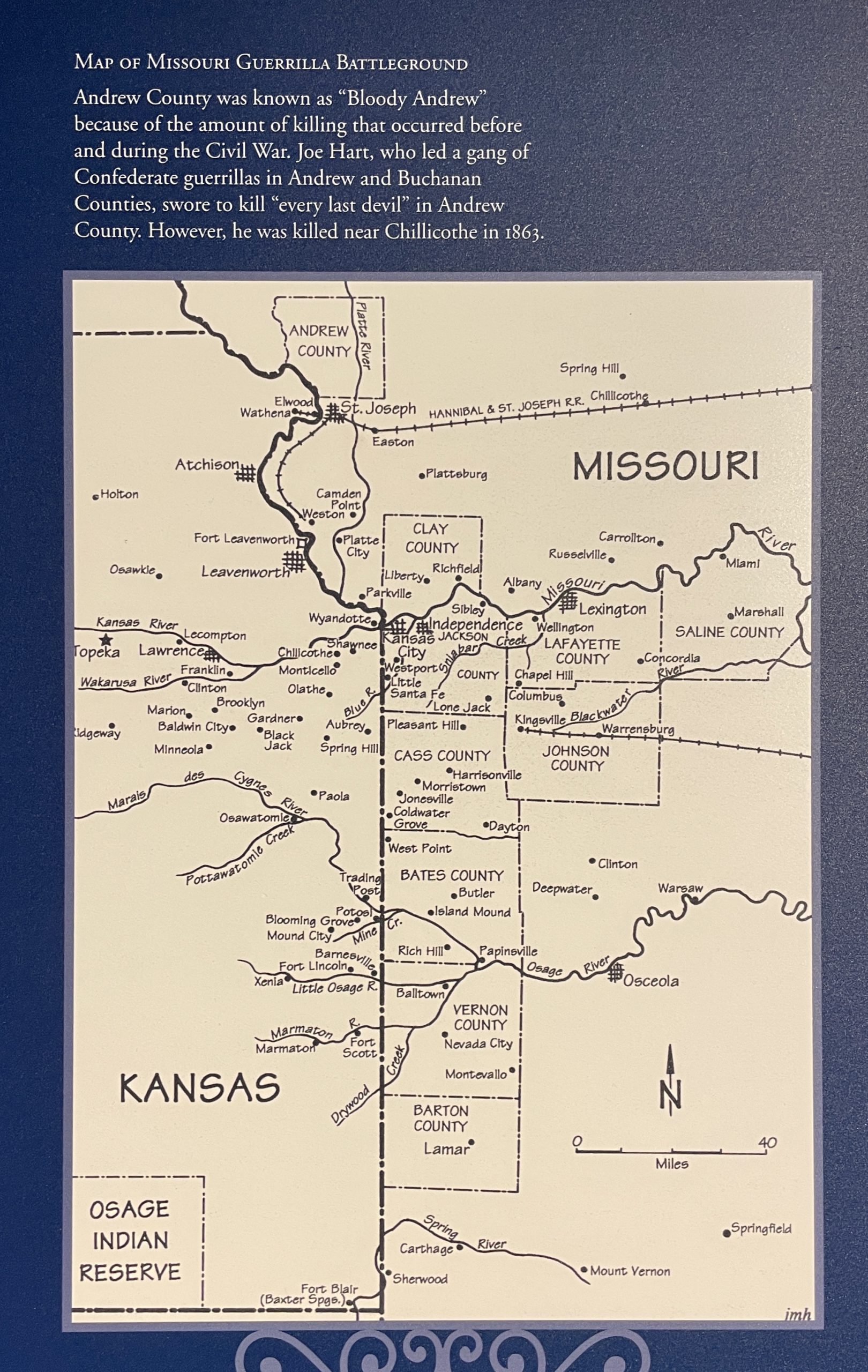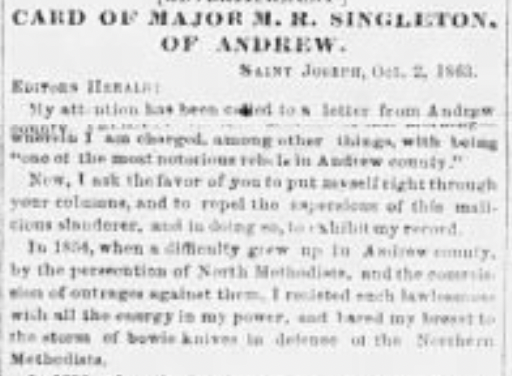Tonya McQuade: Thankful For . . .

Early in 2022, after acquiring fifty family Civil War letters, I began working on a book titled A State Divided: The Civil War Letters of James Calaway Hale and Benjamin Petree of Andrew County, Missouri. It’s a book I’m hoping to eventually see published … and when I do, one of the people who will be at the top of my acknowledgements page is Kathy Ridge.
I met Kathy when my husband and I visited the Andrew County Historical Society and Museum in October 2022. I had arranged a meeting with Kathy ahead of time, hoping she might be able to help me with my family and Civil War research, and she certainly did. Before our arrival, Kathy had already been busy at work, looking up family land deeds in Savannah (where they lived) and any relevant news articles she could find. She also provided information about schools, businesses, and churches that existed in Savannah at the time of the Civil War; maps to find family farms and cemetery locations; statistics on how many families in the area owned slaves and how many men from Andrew County fought on each side in the war; and some insights on how the county was affected by the war.
As I learned earlier from a sign near the Savannah Courthouse: “Andrew County, organized 1841, is one of six counties in the Indian Platte Purchase Territory annexed to Missouri, 1837…. A divided county during the Civil War, Andrew sent troops to both sides. In Aug. 1861, some 1500 from Andrew and other counties joined the pro-Southern Missouri State Guard at Camp Highly in eastern Andrew County while others joined a large Union camp in adjacent Gentry County. In 1861, Union troops seized “Northwest Democrat,” a pro-Southern newspaper in Savannah, and troops from Camp Highly seized the “Plain Dealer,” Union newspaper. Raiding guerrilla bands overran the county through 1863.” [1]

According to Kathy, there is not a lot of information about events in Andrew County and the surrounding area during the war because of the newspapers being destroyed and frequent disruptions to communications due to guerrilla fighting. There was so much killing in the early years of the war that Andrew County was known as “Bloody Andrew,” according to a sign in the museum’s Civil War display. [2]

Kathy was very excited to learn about the Hale and Petree letters. After our visit, she agreed to read my book draft and gave me extremely helpful revision tips and suggestions. What was especially amazing was that Kathy was able to identify so many of the people that my GGG Grandfather, James Calaway Hale, mentioned in his letters. When I first started researching his letters, I worked hard to build out my family tree so I could understand all the family connections he mentioned. However, unless the other names were historical figures, I mostly just ignored them. I figured there was no way for me to know who he might be talking about.
Kathy filled in many of the blanks. For example, in December 1862, James wrote from St. Louis: “I went over on the other side the barracks and I found lots of squares of my old acquaintance, so I had to eat with all of them. I ate five meals Sunday. I see Captain Hobson here, and I seen Ruben Shackleford. He is well. I only got to talk to him – he was going out to town on guard.”
My first reaction, upon reading this, was to smile at the picture of James eating “five meals Sunday” and to feel happy for him that he ran into so many old friends. Digging deeper, I was able to learn more about the background of Captain Hobson since he played a leadership role in the war. Kathy, however, added in her comment: “Reuben S. Shackleford was born in 1843 in Missouri and worked as a day laborer for Rev. Daniel Toole in Andrew County. He enlisted in Savannah on 12 Sep 1862 in 35th Reg Co. C and mustered in at Benton Barracks 30 Sep 1862. He survived the war and mustered out at Little Rock, Arkansas on 28 Jun 1865.” Wow!
In February 1863, James wrote to his wife from Helena, Arkansas, about how “the Regiments all drawed one month’s pay … [and] Col. Pile said he would express all of the money we had to send to our wives. He had a chance to send it up to Memphis where there is an express office, so he told me to direct it to some responsible man in Savannah, so I directed it to William Price, and I sent you ten dollars. So, you can go to Price and get the money when it comes.”
Kathy noted that Price was a respected Savannah merchant born in New York about 1816 and that Savannah named one of its streets after him. I guess that helps explain why James would trust him with the limited funds he had. A later letter confirmed that his wife received the money he sent.
In March 1863, James wrote again from Helena, Arkansas, this time describing his life in camp since he had been too sick to join his regiment when they were sent to Memphis: “But now I will tell you how I have been living since the Regiment went down the river…. Christopher Baker and myself and John Dobbs was left here – only us three of Co. H. We have a whole house to ourselves – a good floor and a door and a brick fireplace – and we are living like kings. None sick but what we have a good stomach to eat, and we have plenty. We drawed a half bushel of Irish potatoes and we have no. 1 flour and we bought soda, so we can have good biscuits all the time. I can beat either of them making biscuit or potato soup.”
Kathy wrote: “Christopher C. Baker and John Dobbs survived the war. Dobbs returned to farm in Andrew County, where he married in 1868, and Baker married in 1870 and lived in both Nodaway County and Holt county.” I was happy to know they survived and made it home. James worried a lot about who in his regiment died in the Battle of Helena, which happened soon after he was transferred to the hospital in St. Louis due to his illness. His first letter from the hospital is dated June 28, 1863. The battle happened on July 4. He just missed it – and 49 men in his regiment died in the battle.
On October 21, 1863, James wrote from the hospital: “I will tell you almost the first man I seen when I was getting off the street car was James Tegarden. He like to never let me go. He told me all the news. I had to go take something to drink with him. I took some brandy and peppermint, and he took whiskey. He says to me, that is the first time you ever seen me drink like that. I told him it was. We went and set down and talked about one hour before we parted…. I had not went far then till I met Burris Adkins. He told me that someone had shot at Mill Singleton two or three times.”
As it turns out, all three of the men James mentions in this passage were from Savannah. Kathy’s census record research revealed the backgrounds and connection between Tegarden and Atkins, but she didn’t say anything about Mill Singleton. Following her lead, however, I did some research and found Milton Robards Singleton in the U.S. Census records. I figured out he was born about 1818 in Kentucky, was a Savannah lawyer, and his wife and four children were living in Savannah with him in 1860 – three years before he was shot.
Through Newspapers.com, I also found a letter Milton Singleton wrote to the Weekly Herald and Tribune in St. Joseph, Missouri on October 8, 1863, defending himself against accusations of being a Rebel. I couldn’t find a story about the shooting itself or whether he lived or died, probably because the Savannah newspaper offices from that time period were destroyed. Clearly, he was being attacked at the time – both by words and bullets.

According to Kathy, Prince L. Hudgins was a lawyer from Savannah, who owned a large amount of land there but was driven out because of his secessionist views. “Billy” was his son, William L. Hudgins. From my research, I found the following description: “Lawyer of St. Louis, Missouri. In 1861 as a delegate to the state convention he spoke and voted against secession, but also spoke against civil war and military coercion of the state authority. He took no part in the Civil War or the politics of the period, but maintained his law practice and took all the required loyalty oaths. In 1863 he was charged with conspiracy for his anti-war speech at the convention. The case was never brought to trial and he received a presidential pardon in March 1865.” [4]
One funny exchange between Kathy and me related to a letter James wrote from the Marine Hospital on October 30, 1863, where we both read the letter different ways – and we still aren’t sure who’s right! James wrote: “Bailis, you need not fear but what you can make money here if this war goes on, which I expect it will. I want you here, but Bailis you do just which you think best. I do wish you was all here now and could get shut of them infernal copperheads. I am afraid some of them will kill you, and if you was here, I don’t think you would be in any danger.”
I automatically assumed that Bailis, my GG Grandfather, must have been bitten by a copperhead snake. Kathy said she laughed when she saw my picture of a copperhead snake, thinking she had completely misread the passage. She assumed he was talking about the Copperheads, a name given to the Peace Democrats, a faction of Democrats in the Union who opposed the American Civil War and wanted an immediate peace settlement with the Confederates. After she wrote that, I thought she was right – but she thinks I’m right. LOL. We’ve both reread the passage several times and still aren’t positive which one he meant, but Kathy does not think there were a lot of political Copperheads in Andrew County at the time, whereas there are a lot of copperhead snakes in the area where James and his family lived.
Kathy certainly proved to me the value of going to the local expert whenever possible to ask questions, seek research assistance, and get reader feedback. Her words also served to provide me great encouragement when she offered her final comments on my book: “These incredible letters give insight into the day by day life of the soldier. They are full of accounts of camp life – boredom, problems, diet, accommodations, mail, routine, hospital care – as well as full of information about the home front. This book is entertaining and interesting. It is educational. It is illuminating. Even though I have read so much ‘Civil War non-fiction,’ I was surprised at how much I learned…. It is a history of the times – it is a history of a family. It is easy to read and easy to understand – one of the top books in its genre.”
I hope someday I can present her with a copy of my book and lead a book talk at the Andrew County Museum!
Endnotes:
- “Andrew County Historical Marker.” Erected by State Historical Society of Missouri and State Highway Commission, 1960. The Historical Marker Database, https://www.hmdb.org/m.asp?m=39756.
- “Taking Sides” Display. Andrew County Museum and Historical Society, Savannah, Missouri, 13 Oct 2022.
- Singleton, Milton. “Card of Major M.R. Singleton of Andrew.” Weekly Herald and Tribune, St. Joseph, Missouri, 8 Oct 1863, Newspapers.com, https://www.newspapers.com/image/351014963/.
- “Hudgins, Prince L.” Social Networks and Archival Context, https://snaccooperative.org/view/3647755.
I know Kathy, she has a delightful PASSION for history and genealogy. She is incredibly knowledgeable and fun to work with! In my opinion, she’s one of a kind and the ACM and visitors are so lucky to have her.
I, too, had a wonderful visit at the Museum just recently. I am trying to seal my relationship to Benjamin Petree. Came across this post and would like to visit with Tonya. Thank you.